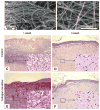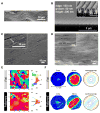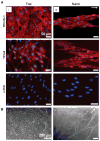Nanotopography-guided tissue engineering and regenerative medicine
- PMID: 22921841
- PMCID: PMC5444877
- DOI: 10.1016/j.addr.2012.07.014
Nanotopography-guided tissue engineering and regenerative medicine
Abstract
Human tissues are intricate ensembles of multiple cell types embedded in complex and well-defined structures of the extracellular matrix (ECM). The organization of ECM is frequently hierarchical from nano to macro, with many proteins forming large scale structures with feature sizes up to several hundred microns. Inspired from these natural designs of ECM, nanotopography-guided approaches have been increasingly investigated for the last several decades. Results demonstrate that the nanotopography itself can activate tissue-specific function in vitro as well as promote tissue regeneration in vivo upon transplantation. In this review, we provide an extensive analysis of recent efforts to mimic functional nanostructures in vitro for improved tissue engineering and regeneration of injured and damaged tissues. We first characterize the role of various nanostructures in human tissues with respect to each tissue-specific function. Then, we describe various fabrication methods in terms of patterning principles and material characteristics. Finally, we summarize the applications of nanotopography to various tissues, which are classified into four types depending on their functions: protective, mechano-sensitive, electro-active, and shear stress-sensitive tissues. Some limitations and future challenges are briefly discussed at the end.
Crown Copyright © 2012. Published by Elsevier B.V. All rights reserved.
Figures





References
-
- Messenger MP, Tomlins PE. Regenerative medicine: a snapshot of the current regulatory environment and standards. Adv Mater. 2011;23:H10–H17. - PubMed
-
- Mason C. Regenerative medicine 2.0. Regen Med. 2007;2:11–18. - PubMed
-
- Carter SB. Principles of cell motility: the direction of cell movement and cancer invasion. Nature. 1965;208:1183–1187. - PubMed
-
- Zhao M, Song B, Pu J, Wada T, Reid B, Tai GP, Wang F, Guo AH, Walczysko P, Gu Y, Sasaki T, Suzuki A, Forrester JV, Bourne HR, Devreotes PN, McCaig CD, Penninger JM. Electrical signals control wound healing through phosphatidylinositol-3-OH kinase-gamma and PTEN. Nature. 2006;442:457–460. - PubMed
Publication types
MeSH terms
Grants and funding
LinkOut - more resources
Full Text Sources
Other Literature Sources

